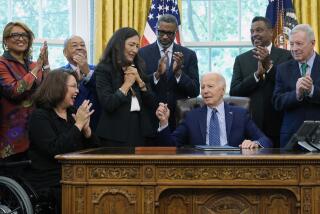Ferguson unrest reflects decades of racial tension in St. Louis area
The roots of the racial unrest that has racked Ferguson, Mo., this week go back more than a century in a region that has had one foot planted in the Midwest and another in the South, historians and sociologists say.
“The St. Louis metropolitan area has been an extreme example of racial segregation for 100 years,” said Clarissa Hayward, an associate professor of political science at Washington University in St. Louis. “St. Louis is the beginning of the West, the nexus of the Midwest and at the border of the South.”
The practices and politics of St. Louis created the problems that underlie the tension that boiled out in Ferguson this week, Hayward said.
St. Louis enacted racial zoning laws in 1916 that were struck down the following year, Hayward said. But the city turned to racial covenants on property deeds to preserve its segregation. The system continued until 1948, when the U.S. Supreme Court struck it down in its landmark Shelley vs. Kraemer decision.
The city’s economy has been tied to the Midwest Rust Belt, failing to benefit from the last several decades of industrialization in the South. The metropolitan area lost two Chrysler assembly plants, as well as a Ford assembly plant, among many industrial losses to its economy.
Meanwhile, its repressive social sensibilities pushed its black population into a ring of suburbs that have poorly funded schools and local governments still dominated by white officials.
“Ferguson is part of a suburban ring that was white until the 1970s when the blacks could begin to move,” said Margaret Garb, an associate history professor at Washington University. “Many blacks went to Ferguson from north St. Louis, which was devastated by industrial closures and bleak project housing.”
The suburban school districts have been so poorly funded that some of them lost their accreditation, the result of funding cutbacks by the state, and students were forced to accept busing to other school districts, Garb said.
“There is a debate over whether St. Louis is a Southern city or a Midwest city,” Garb added. “The great migration of blacks early in the 20th century had a big impact on St. Louis, which was a stopping-off point for many on the journey to Chicago and Detroit.
“They arrived just as the good jobs were leaving,” she said. “That is one of the stories of the black migration.”
The city peaked about 1950, when the census reported 850,000 residents. By the 2010 census, it had dropped to just 320,000, even while the metropolitan area had surged to 6 million.
The area’s long history with segregation may offer some explanation of why the police tactics this week in Ferguson appeared to inflame residents rather than keep the peace.
“When I learned that the police department was 95% white in a predominantly black city I was surprised,” said Clark McPhail, an emeritus professor at the University of Illinois at Urbana-Champaign and one of the nation’s top experts on police tactics in controlling assembled groups.
McPhail said his assessment of their tactics was also a surprise. “They were way behind the curve in their training and the way they responded. Tear gas is almost guaranteed to turn the crowd against the police. They were out of it.”
McPhail said the police were geared up for a major confrontation when there was little reason to expect a lethal confrontation.
“We have data of tens of thousands of protest events for the 20th century and the 19th century and violence occurs in 10% or 15% of the cases,” he said. “If police are not trained that way, they show up scared to death.
“If police grant the protesters some leeway rather than react to trivial violations of the law, it can be possible to defuse it,” he said.
Follow @rvartabedian to more national news.
More to Read
Sign up for Essential California
The most important California stories and recommendations in your inbox every morning.
You may occasionally receive promotional content from the Los Angeles Times.











